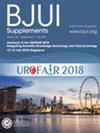Sentinel lymph node staging in urological cancer surgery: advances in imaging, intra‐operative detection and translational research
IF 4.4
2区 医学
Q1 UROLOGY & NEPHROLOGY
引用次数: 0
Abstract
ObjectivesTo review the clinical utility, outcome and possible future applications of sentinel lymph node biopsy (SLNB) in penile cancer (PeC), bladder cancer (BCa), prostate cancer (PCa), testicular cancer (TCa) and renal cell carcinoma (RCC), focusing in particular on current SLNB standards and exploring advancements in imaging agents, intra‐operative detection, surgical navigation, and the potential application of SLNB in translational and clinical research.MethodsA literature search was conducted in PubMed and EMBASE for studies published between 2000 and 2024, providing a narrative review of SLNB in oncological urology.ResultsIn PeC, SLNB offers a lower adverse event rate compared to inguinal lymph node (LN) dissection, while maintaining high detection rates and acceptable sensitivity (92%–96%) for identifying inguinal LN metastases. Similarly, in PCa, SLNB achieves a sensitivity of 95%, potentially reinforcing its role in nodal staging and guiding personalised treatment strategies. For RCC, BCa and TCa, SLNB is currently under investigation in trials. In RCC, detection rates seem acceptable; however, in BCa and TCa, detection rates and false‐negative rates vary, limiting its clinical usefulness. Contemporary approaches utilise various radiotracers, (fluorescent) dyes, and hybrid tracers for SLNB. Ongoing research refines tumour‐targeted LN detection, including prostate‐specific membrane antigen targeting in PCa, potential c‐MET targeting in PeC, and泌尿外科肿瘤前哨淋巴结分期:影像学、术中检测和转化研究进展
目的回顾前哨淋巴结活检(SLNB)在阴茎癌(PeC)、膀胱癌(BCa)、前列腺癌(PCa)、睾丸癌(TCa)和肾细胞癌(RCC)中的临床应用、结果和可能的未来应用,特别关注当前的SLNB标准,探讨显像剂、术中检测、手术导航的进展,以及SLNB在转化和临床研究中的潜在应用。方法在PubMed和EMBASE中检索2000 - 2024年发表的文献,对肿瘤泌尿外科SLNB的研究进行综述。结果与腹股沟淋巴结清扫术相比,在PeC中,SLNB的不良事件发生率较低,同时在识别腹股沟淋巴结转移方面保持较高的检出率和可接受的灵敏度(92%-96%)。同样,在前列腺癌中,SLNB的敏感性达到95%,可能加强其在淋巴结分期中的作用,并指导个性化治疗策略。对于RCC、BCa和TCa, SLNB目前正在临床研究中。在肾细胞癌中,检出率似乎是可以接受的;然而,在BCa和TCa中,检出率和假阴性率各不相同,限制了其临床应用。现代方法利用各种放射性示踪剂,(荧光)染料和混合示踪剂的SLNB。正在进行的研究改进了肿瘤靶向LN检测,包括前列腺特异性膜抗原靶向PCa,潜在的c - MET靶向PeC,以及89Zr -吉伦妥昔单抗靶向RCC。结论SLNB的使用改变了PeC的淋巴结分期,影响了手术患者的治疗决策并降低了发病率。在其他泌尿系统恶性肿瘤中,它尚未成为淋巴结分期的标准工具。它对生存、生活质量和转化研究的影响仍有待确定。
本文章由计算机程序翻译,如有差异,请以英文原文为准。
求助全文
约1分钟内获得全文
求助全文
来源期刊

BJU International
医学-泌尿学与肾脏学
CiteScore
9.10
自引率
4.40%
发文量
262
审稿时长
1 months
期刊介绍:
BJUI is one of the most highly respected medical journals in the world, with a truly international range of published papers and appeal. Every issue gives invaluable practical information in the form of original articles, reviews, comments, surgical education articles, and translational science articles in the field of urology. BJUI employs topical sections, and is in full colour, making it easier to browse or search for something specific.
 求助内容:
求助内容: 应助结果提醒方式:
应助结果提醒方式:


